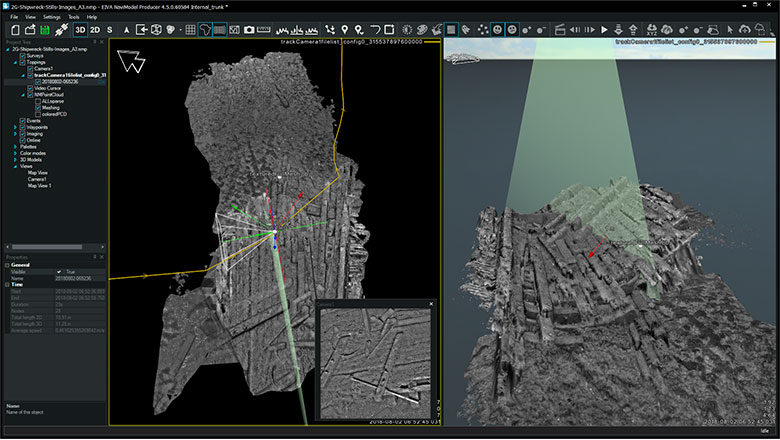
To use this site, please enable javascript

To use this site, please enable javascript
Drones are replacing people. With the help of leading manufacturers, drones are reaching levels of independence never seen before. To achieve self-reliance, a drone needs to detect and process new sensory data, and then decide how to act upon the information. Essentially, they need to ‘think’ for themselves.
EIVA is providing the software that makes this autonomy a living, breathing reality. The following article describes how USVs, ROVs and AUVs are achieving autonomy with the help of NaviSuite software.

3D mesh reconstruction using EIVA’s VSLAM on subsea survey images of a wreck
The USV initially functioned as both an operator and remotely controlled drone, whereas today they are running pre-programmed missions on autopilot. With the addition of more sensors, a USV gains the ability to process visual information, and with the addition of onboard software, a USV can process data and supervise itself.
Achieving autonomy involves adaptive behaviour by the USV, to cover specific areas in an efficient manner. By automatically determining the best runline based on collected data, and by avoiding objects and areas based on sensor input, the USV becomes self-correcting, and responds as if thinking for itself.

A fully automated USV acquiring and processing data during a survey while using a combination of NaviScan, NaviPac and Workflow Manager
In contrast, the ROV is still dependant on operator control; the umbilical link which allows for the transfer of information and power is yet to be cut. Even though modern steering features provide for automatic route following, or on the opposite end of the scale, station keeping, which keeps the ROV stationary in strong currents, the ROV is a little further from autonomy than the USV. However, with the right connectivity, operators can control an ROV from the comfort of an office.
Remote control was one step in the direction of EIVA’s vision for complete autonomy, where NaviSuite Mobula software provides ROV control through both manual and assisted steering. The next step involves the ROV automatically determining the most efficient way to inspect a structure, or to follow an object underwater.

NaviSuite Mobula allows for total control of the BlueROV2 while displaying sonar and recording time-stamped data
An AUV operation requires detailed mission planning and execution. Monitoring during the operation can be difficult due to limited real-time connectivity, which can then affect the outcome when positional errors are not corrected. In response to this problem, EIVA want to promote intelligent behaviour from the AUV by giving it software to ‘think’ for itself, which in turn will simplify the planning and execution.
The new adaptive behaviour of the AUV will allow it to react and respond based on sensor input, while a mission planning function implemented in EIVA’s user-friendly desktop software will simplify planning. Offshore operations are optimised by letting the AUV take on some of the heavy lifting in terms of processing data, leaving scientists and researchers time to focus on other areas of the operation.
Without onboard processing, the time it takes to recover, process, and re-survey would cancel out the benefits of operational efficiency as a result of smarter drones. To reduce this burden of overwhelmingly large amounts of data, EIVA provides onboard processing for both USVs and AUVs, so that the data is ready to use when the drone is recovered.

High quality data collection and reduced processing times with EIVA’s Deep Learning
Yet to be truly autonomous, and for a drone to reach independence, data must be analysed during the operation. EIVA’s Deep Learning automatically identifies objects of interest. In the pipeline inspection industry, Deep Learning technology searches for debris, damage, joints, anodes and anomalies, among others. By ignoring redundant data, drones can perform efficiently by determining what’s important to the operation and therefore ‘think’ for themselves.
The eyes of the AI; EIVA’s unique single-camera VSLAM provides high-quality point clouds and allows for 3D mesh generation, which map the area of interest for an artificial intelligence. ArUco markers facilitate in the tracking of an object’s orientation and location, which can be used in guidance when docking, but in this case, empowers drones with the gift of sight. When combining these factors, drones gain a clarity of vision that far supersedes that of the human eye, especially the ability to see underwater.

3D mesh generated by EIVA’s VSLAM from existing survey imagery
Drones will replace people, increase efficiency, and add new capabilities to subsea operations – and to a much larger extent than we see today. Not only has a drone the potential to operate much faster and more efficiently than us, both on and under the water, they remove the need for us to spend time in environments in which we are vulnerable – in other words, safety from conditions at sea.
In short, drones are the future. To achieve autonomy, and for us to benefit from their independence, EIVA’s sophisticated software will ensure their function is more efficient, or at least equally as effective as their performance when operated by a human.
If you have any questions, or believe EIVA's NaviSuite software could benefit your operation, then please feel free to get in touch.